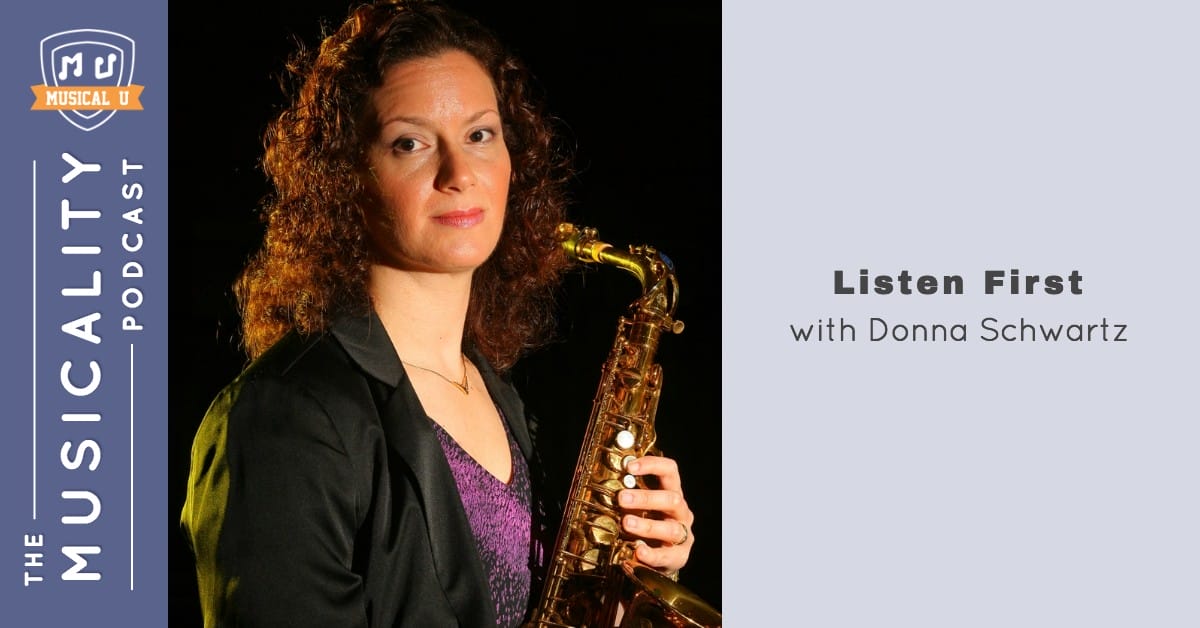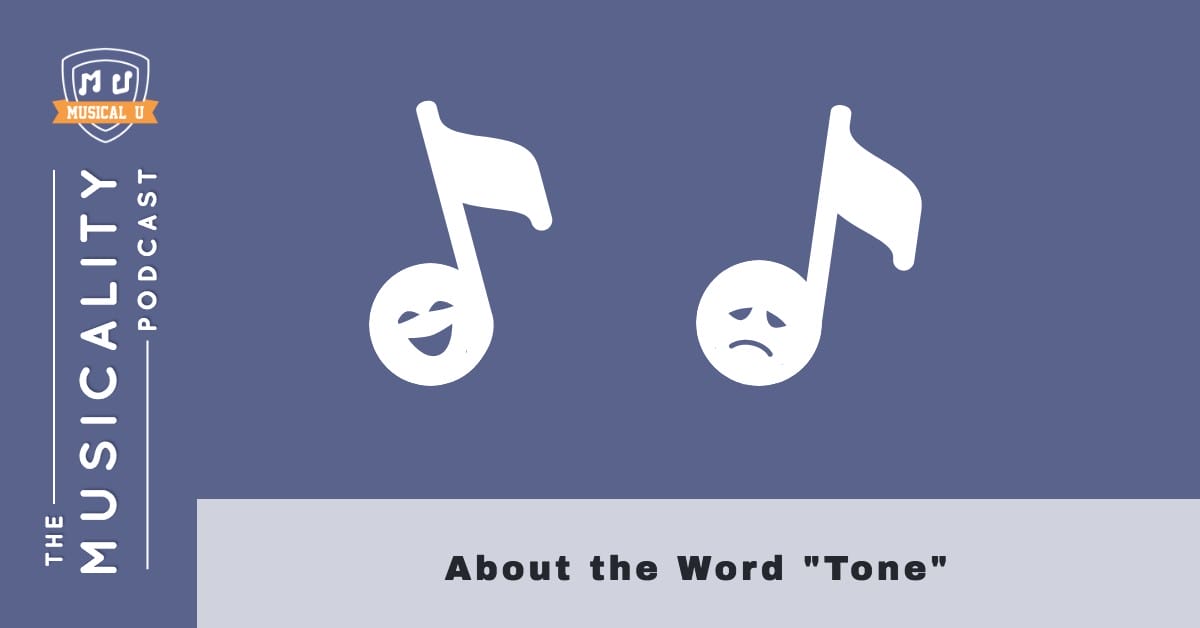What makes a “natural” musician, and what sets one apart from one who is merely technically skilled?
Often, the difference is that the natural musician really listens – listens to the quality of a sound and not just whether it’s in tune, listens to fellow players when jamming, and listens to themselves when practicing.
This week, we interview a music teacher and an up-and-coming indie rock band who both embody this “listening” philosophy, and give you some clarity on that nebulous word “tone” – and how to listen for it.
But first, please turn your attention to the past month’s exciting new offerings here at Musical U…
April’s Arrivals
This past month has seen the introduction of some incredibly exciting and long-anticipated new material here at Musical U, as well as a slight change to how getting a membership with us works.
 Here are a few hints to pique your interest…
Here are a few hints to pique your interest…
We introduce a fantastic tool to get you going with improvisation: the almighty Improvisation Roadmap! Things are brewing over in the Instrument Pack department also, with the release of new Resource Packs for piano, guitar, bass, and singing. And finally, we’ve recently introduced a new system for joining Musical U; a system that will ensure we can give each new member the attention and support they deserve.
Head over to What’s New in Musical U: April 2018 to get the full information on our new content, and how you can sign up to Musical U with our new system!
Using Your Ears
If we are taught to speak before we learn to read and write, why are we ever expected to be able to read music before we can play? After all, the point of the language of music is to freely express and communicate!
This week on the Musicality Podcast, we speak with Donna Schwartz, one of the world’s best-known online saxophone teachers and the co-host of the Everything Saxophone podcast. In this in-depth interview, Donna discusses her teaching philosophy – one that places the emphasis on imagining the music before you even play it, or “listening first” – and the musical benefits it yields.
 Feast your ears on Listen First, with Donna Schwartz to learn about how Donna extends this M.O. to every facet of her teaching and playing.
Feast your ears on Listen First, with Donna Schwartz to learn about how Donna extends this M.O. to every facet of her teaching and playing.
Donna’s first instrument wasn’t the saxophone – it was the trumpet! Like many beginner musicians, Donna had trouble getting some of the basics down at the start. For her, it came down to something as simple (and essential!) as the embouchure that a trumpet player needs to produce sound. The trumpet is a great instrument to pick up, and learning how to produce the basic buzzing sounds required to play can give you a leg up. Aaron from The Black Trumpeter takes us through some basic buzzing exercises.
We’ve talked about performance anxiety several times on this page, and it seems to come up on a regular basis. And for good reason… many musicians struggle with playing in front of other people! No matter how prepared you are, the critical days and hours before a performance can make the difference in your ability to perform. Gina walks us through her pre-performance routine with some great suggestions that will help you feel more comfortable and perform your best.
Donna had an unorthodox teacher who required her to sing before playing any of the passages in her music. This is not only good for ear training, but can help make you a more effortless and expressive performer. And before you ask, yes, this counts for “non-singers” as well! Lauren from Jam with Lauren discusses the benefits of singing before playing a musical piece.
No matter how much you practice a piece of music, learning to listen to others is just as important for your musical growth. Donna shared her insights on how she would go through the literature to find recordings that she could study before playing any piece. Many musicians would agree that learning to listen is one of the most important aspects to growing your musicality. Music House School provides some suggestions on how you can evolve your listening skills.
Chemistry with CNVS
All the chops in the world can’t help you if you’re missing that crucial element that makes a band a band, and not just a group of musicians playing together.
That element, of course, is chemistry.
 Mexican indie rock band CNVS is known for their high-energy, melodic tunes, strong visual aesthetics, and dynamic musical interaction during live shows. After two years of writing and production, the band is finally about to release their much-anticipated debut LP, appropriately titled Gran Copiloto, or “the best sidekick you’ve ever had”.
Mexican indie rock band CNVS is known for their high-energy, melodic tunes, strong visual aesthetics, and dynamic musical interaction during live shows. After two years of writing and production, the band is finally about to release their much-anticipated debut LP, appropriately titled Gran Copiloto, or “the best sidekick you’ve ever had”.
In Musical Chemistry, with CNVS, the band’s lead guitarist speaks with us about their group songwriting process, and how they stay true to the music in the age of branding and social media.
It was a pleasure to hear CNVS’s story in this interview. We are always interested to hear how musicians were able to make the transition from playing in the garage (or basement…) to becoming accomplished recording artists. For a step-by-step guide to making this transition, we turn to Bree Noble from Female Entrepreneur Musician.
How does a band come up with their song ideas? There is no one answer to this, as the dynamics in every band can be quite different. For CNVS, most of their original songs came as the result of jam sessions. Music Industry How To provides insight into why bands should jam, jam, and then jam some more.
We first discovered CNVS through a cover song that they produced for an earlier album. Covers are not only fun to play, but they are also a great way to get exposure and to jump start your songwriting. Playing other musicians’ music is just one of the tips that Graham from Speed Songwriting suggests for kick-starting your songwriting habit. Take a quick read and get writing!
CNVS credits their music and success to remaining true to themselves. In an industry with so many copycat artists, this is refreshing and can certainly be heard in their music! Jason Chapman, a musician with a similar ethos, reveals the path that his music has lead him on in this fascinating interview.
All About Tone
With the plethora of musical terminology for us to learn, things can get extra wonky when you have a word with multiple meanings.
 In no situation is this truer than with the word “tone”, a musical chameleon that has wildly different meanings depending on the context it’s used in.
In no situation is this truer than with the word “tone”, a musical chameleon that has wildly different meanings depending on the context it’s used in.
In About the Word “Tone”, we discuss how the term can be used to describe a note, a frequency, or an interval, and give you some context for helping determine which one applies in a given situation.
Pitch, frequency, tone… how many terms are we to have for our musical foundations?! It can be confusing for any musician, no matter how experienced, to navigate the complex world of musical terms and expressions. Bharat from Euphonic Space discusses the difference between pitch and frequency in his helpful illustrated lesson.
Perhaps even more important than the individual tones is the relationship that pitches have with one another. We often express these relationships as intervals, which is the distance between two pitches. When grouped together, intervals form chords. Hear and Play discusses some essential intervals in chord formations to help enhance your musicality.
We discussed whole tones and semitones during this episode on tone. When placed together in the correct order, tones and semitones will form what is known as the diatonic scale. DamProg Music provides a closer look at this special pattern.
Many musicians will tune to a specific tone. In the orchestra, this is typically A = 440 Hz. Learning to tune your instrument – and therefore the notes that you are playing – is one way to improve your intonation. For some more tips on increasing your intonation, this assortment of tips from band directors will take you a long way.
Feast Your Ears!
The most important tool for a musician isn’t that fancy vintage Les Paul, or even your hands.
In the same way that your hands can be trained to perform a variety of feats on your instrument, your ears can be trained to help you learn some incredible skills: improvisation, playing by ear, sight reading, and jamming effortlessly with others, to name a few.
Best of all, ear training is complementary – practice one skill, and you’ll find you’re improving on others, too – and your hands will follow suit.
We at Musical U emphasize ear training for a good reason: it’s the key to unlocking your inner musician. Eager to get started? Reserve your spot on the waitlist now to get access to our unparalleled training as soon as possible!
The post April’s Arrivals, Using Your Ears, Chemistry with CNVS, and All About Tone appeared first on Musical U.